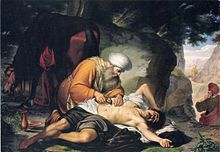Giacomo Conti (painter)
Giacomo Conti (born November 2, 1813 in Messina , † April 9, 1888 in Florence ) was an Italian painter from Sicily .
Life
Conti became known as a history painter and painter of religious motifs. He received his first training from Letterio Subba (1797–1868) in Messina. With a scholarship from his hometown, Conti went to Rome in 1834 to the Accademia di San Luca , where Francesco Coghetti (1804–1865) and Francesco Podesti (1800–1895) were his teachers.
At the end of 1836 he returned to Messina, where he worked as a portraitist and illustrator. In 1843 he continued his education at the Istituto di Belle Arti in Siena . In Florence he exhibited his first painting " La disfida di Barletta ", which was acquired by Grand Duke Leopold II . A cycle of four paintings with scenes from the Risorgimento was also created in Florence .
Many of the pictures and frescoes he painted for Messina were lost in the great earthquake of 1908 , including the paintings “The Sicilian Vespers ” and “Romeo's Death”, as well as the ceiling fresco “The Story of Saint Benedict”.
He was represented at exhibitions, including in Florence (1861) and Turin (1884).
A large part of his artistic estate is in the Gabinetto Disegni e Stampe (Florence) and in the Accademia di Belle Arti di Carrara .
Works (selection)
- Teatro Vittorio Emanuele II (Messina) ceiling fresco (1859)
- Cathedral of San Sebastiano ( Barcellona Pozzo di Gotto ): "Martyrdom of Saint Sebastian" (1869)
- Accademia di Belle Arti ( Carrara ): Study on "Martyrdom of Saint Sebastian" and "The Samaritan Woman at the Well"
- Messina Exchange "Dance of the Hours"
- Private collection in Messina: "Dance of the Hours"
- Collereale Hospital (Messina): Portrait of Giovanni Capece, Principe di Collereale
- Museo Regionale (Messina) : "The parable of the Good Samaritan"
- Accademia di San Luca (Rome): chalk drawing of a male figure in the archive
literature
- Conti, Giacomo . In: Ulrich Thieme (Hrsg.): General Lexicon of Fine Artists from Antiquity to the Present . Founded by Ulrich Thieme and Felix Becker . tape 7 : Cioffi – Cousyns . EA Seemann, Leipzig 1912, p. 335 ( Textarchiv - Internet Archive - Different dates of life: * November 2, 1818 and year of death 1889).
- Daniela Moretti: In: Dizionario Biografico degli Italiani. Volume 28, Conforto – Cordero. Istituto della Enciclopedia Italiana, Rome 1983 ( treccani.it ).
| personal data | |
|---|---|
| SURNAME | Conti, Giacomo |
| BRIEF DESCRIPTION | Italian painter |
| DATE OF BIRTH | November 2, 1813 |
| PLACE OF BIRTH | Messina |
| DATE OF DEATH | April 9, 1888 |
| Place of death | Florence |
